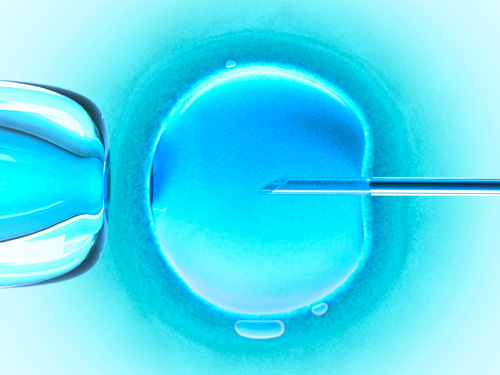
The aim of this treatment is to achieve an adequate number of eggs through controlled stimulation of the ovaries. Subsequently, the eggs will be fertilized in an Assisted Reproduction laboratory with the partner's semen, using cutting-edge technology and highly trained personnel, which increases the probability of pregnancy.
This method is recommended in the following cases:- Women over 36 years old.
- Failures in artificial inseminations.
- Obstructed fallopian tubes.
- Endometriosis.
- Vasectomy.
- Severe seminal alteration. Teratozoospermia, REM lower than 5 million/0.5 ml.
- Absence of sperm in the semen, but present in testicular biopsy.
In Vitro Fertilization can be summarized in the following stages:
-
1. Ovarian Stimulation:
Begins on the first or second day of menstruation with injectable hormones (Gonadotropins), which are hormones naturally produced by women but administered in higher doses. This lasts between 8 and 10 days. Dosages are calculated based on age, weight, height, and follicular endowment, aiming for multiple ovulation (around 6 to 10 follicles). Gentle stimulations, better tolerated by patients, are standardized in our center, as high-dose hormonal stimulations have not been proven to improve pregnancy rates and may lead to potential complications.
-
2. Follicular Monitoring:
Between the 3rd and 5th day of medication administration, the first ultrasound control is carried out. Hormonal determination is based on follicular development, and measuring serum estradiol is not always necessary. From this first control, the patient will be seen every 24-48 hours for follicular development monitoring and medication adjustment if needed. Another hormone we determine before ending treatment is serum Progesterone, especially if endometrial characteristics are not optimal or there is suspicion of premature ovulation, which could create unfavorable conditions for embryonic implantation.
-
3. Oocyte Retrieval - Follicular Puncture:
The maturation of the eggs ends with a final injection, which promotes ovulation, also known as the “trigger”. The follicular puncture is scheduled 36 hours after this injection. On the day of oocyte retrieval, the woman must arrive at the center fasting for at least 8 hours, without makeup, perfume, antiperspirant, or any other odor-releasing substances. Before starting the procedure, a vein in the arm is cannulated with a solution, and the patient is prepared for a short and superficial anesthesia to perform the follicular puncture without any discomfort. The procedure lasts about 15 to 20 minutes. The doctor uses a thin needle guided by ultrasound to penetrate the vaginal wall to the ovary, aspirating the content of the follicles to retrieve the eggs. This procedure is performed in the operating room.
-
4. In Vitro Fertilization:
After follicular puncture, the couple provides a semen sample through masturbation. In the IVF laboratory, fertilization is carried out in two ways:
a) Conventional: eggs and prepared sperm are placed together in a glass dish to allow fertilization.
b) ICSI (Intracytoplasmic Sperm Injection): This technique involves injecting a single sperm directly into the egg with a micro needle to facilitate fertilization. It is used when the number of mobile and normal sperm is too low to ensure fertilization, in cases of insemination failure, or whenever there is the slightest suspicion of fertilization difficulties. Over 90% of our patients undergo ICSI.
While conventional IVF is usually used in very selected cases and combined with ICSI (50% of the oocytes are allocated to each technique). Once fertilization occurs, the development of the obtained embryos is observed.
The gynecologist or embryologist will inform daily about the evolution of the embryos until the transfer.
-
5. Embryo Transfer:
This involves placing one or two embryos into the woman's uterus through the vagina using a specially designed catheter. This procedure generally takes place 3 to 6 days after oocyte recovery, according to the embryo development. It's important that no chemical substances that release odors or could harm the embryos, such as makeup or antiperspirant, are applied. This process does not require anesthesia and lasts about 5-15 minutes.
-
6. Pregnancy Test
Performed 10-12 days after the embryo transfer, using a quantitative determination of the pregnancy hormone.